Team Leadership Report: Performance, Problem Solving, and Change
VerifiedAdded on 2022/08/08
|7
|1805
|49
Report
AI Summary
This report delves into the multifaceted aspects of team leadership, examining critical concepts such as team obstacles, team endings, and the challenges of teams getting stuck. It explores the impact of various factors on team performance, including ethical considerations, performance ethics, and the significance of clear objectives. The report also addresses the inevitability of team changes, emphasizing problem-solving approaches to manage these transitions effectively. Furthermore, it discusses the complexities of forming a team at the top level, contrasting teams with working groups and highlighting the importance of collaborative problem-solving models. The report emphasizes systematic approaches for data display and analysis, alongside the use of diverse tools like flowcharts and charts, to aid in problem-solving within teams. Overall, the report underscores the importance of these concepts for effective team functioning and highlights the role of team leaders in navigating these complexities to achieve organizational goals.
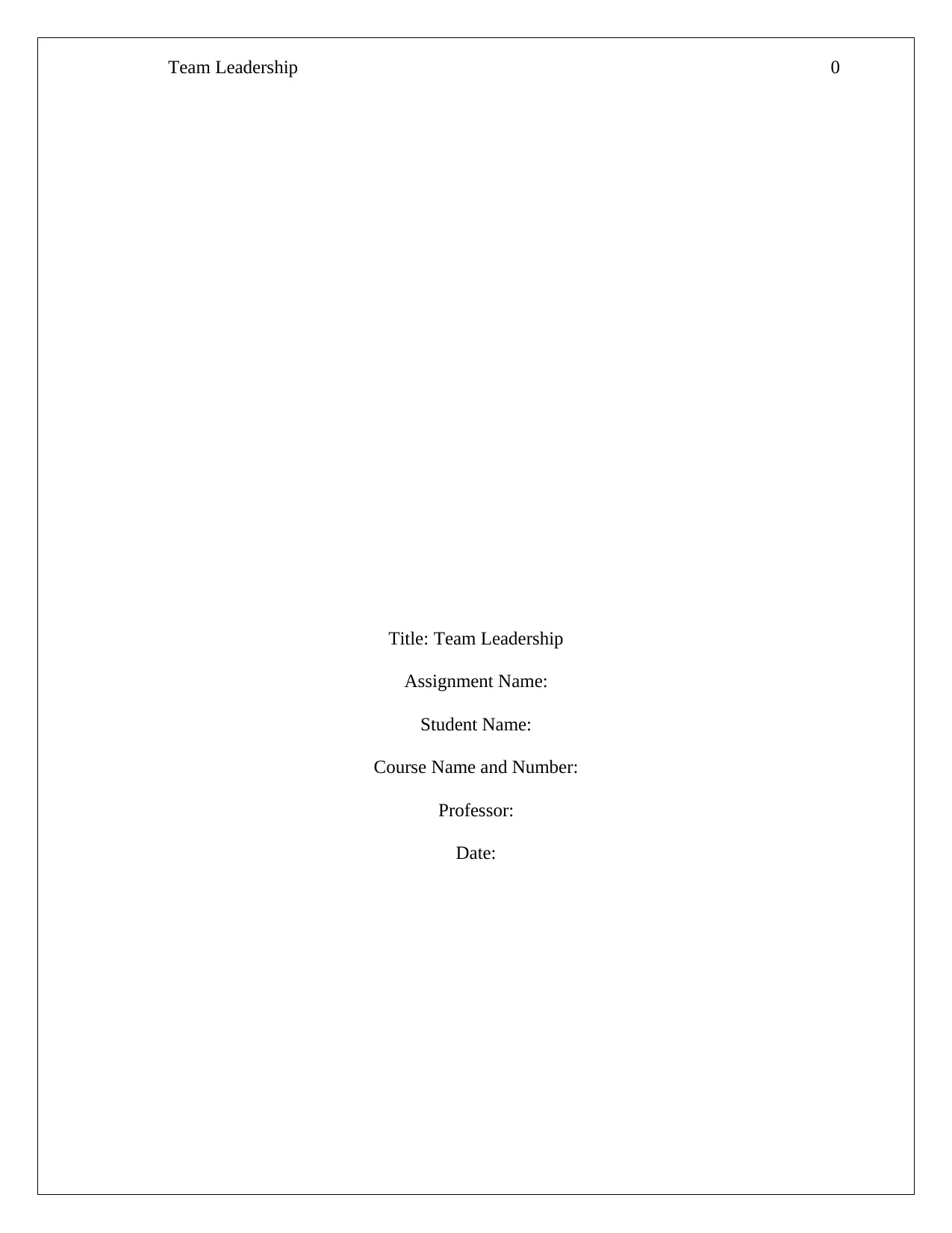
Team Leadership 0
Title: Team Leadership
Assignment Name:
Student Name:
Course Name and Number:
Professor:
Date:
Title: Team Leadership
Assignment Name:
Student Name:
Course Name and Number:
Professor:
Date:
Paraphrase This Document
Need a fresh take? Get an instant paraphrase of this document with our AI Paraphraser
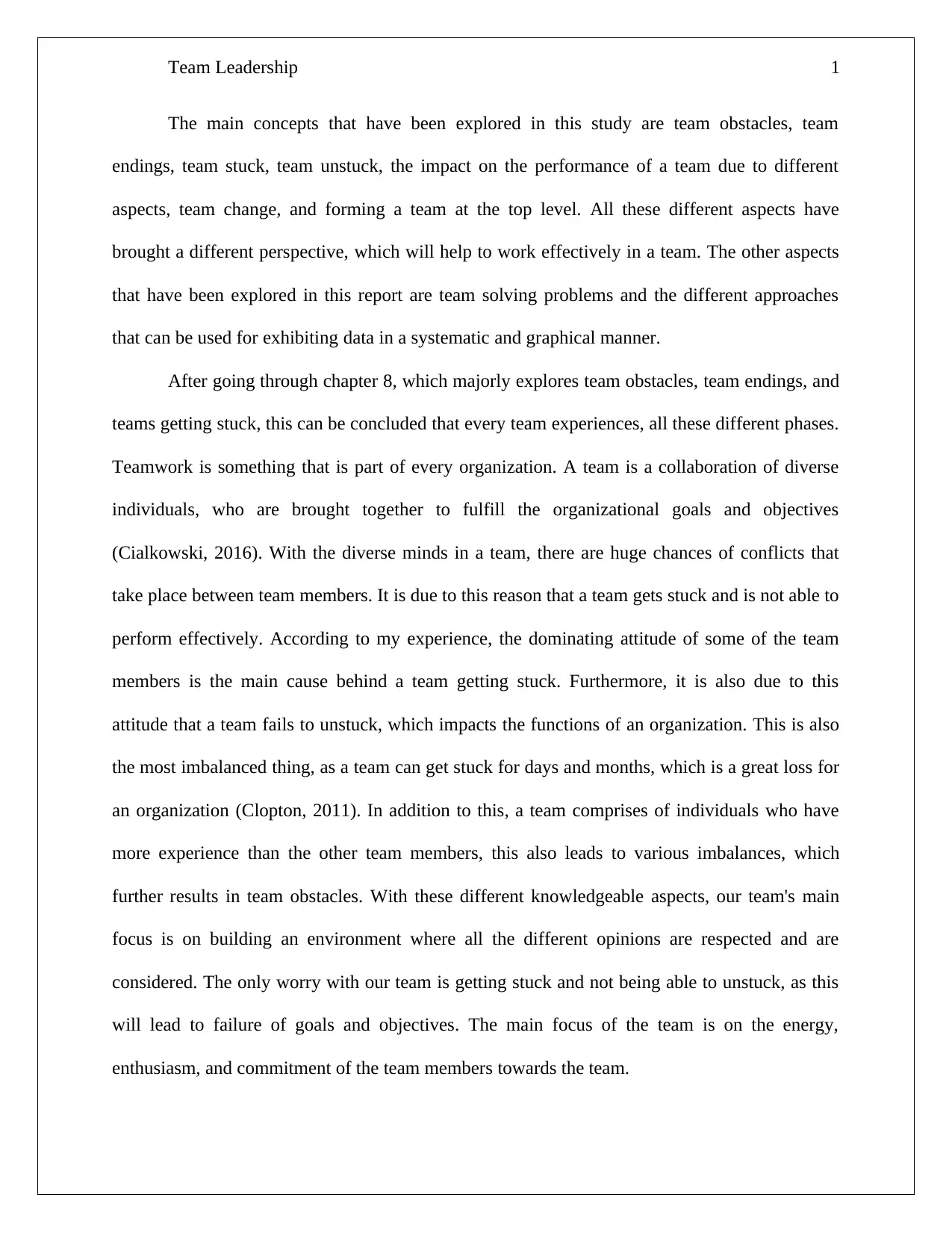
Team Leadership 1
The main concepts that have been explored in this study are team obstacles, team
endings, team stuck, team unstuck, the impact on the performance of a team due to different
aspects, team change, and forming a team at the top level. All these different aspects have
brought a different perspective, which will help to work effectively in a team. The other aspects
that have been explored in this report are team solving problems and the different approaches
that can be used for exhibiting data in a systematic and graphical manner.
After going through chapter 8, which majorly explores team obstacles, team endings, and
teams getting stuck, this can be concluded that every team experiences, all these different phases.
Teamwork is something that is part of every organization. A team is a collaboration of diverse
individuals, who are brought together to fulfill the organizational goals and objectives
(Cialkowski, 2016). With the diverse minds in a team, there are huge chances of conflicts that
take place between team members. It is due to this reason that a team gets stuck and is not able to
perform effectively. According to my experience, the dominating attitude of some of the team
members is the main cause behind a team getting stuck. Furthermore, it is also due to this
attitude that a team fails to unstuck, which impacts the functions of an organization. This is also
the most imbalanced thing, as a team can get stuck for days and months, which is a great loss for
an organization (Clopton, 2011). In addition to this, a team comprises of individuals who have
more experience than the other team members, this also leads to various imbalances, which
further results in team obstacles. With these different knowledgeable aspects, our team's main
focus is on building an environment where all the different opinions are respected and are
considered. The only worry with our team is getting stuck and not being able to unstuck, as this
will lead to failure of goals and objectives. The main focus of the team is on the energy,
enthusiasm, and commitment of the team members towards the team.
The main concepts that have been explored in this study are team obstacles, team
endings, team stuck, team unstuck, the impact on the performance of a team due to different
aspects, team change, and forming a team at the top level. All these different aspects have
brought a different perspective, which will help to work effectively in a team. The other aspects
that have been explored in this report are team solving problems and the different approaches
that can be used for exhibiting data in a systematic and graphical manner.
After going through chapter 8, which majorly explores team obstacles, team endings, and
teams getting stuck, this can be concluded that every team experiences, all these different phases.
Teamwork is something that is part of every organization. A team is a collaboration of diverse
individuals, who are brought together to fulfill the organizational goals and objectives
(Cialkowski, 2016). With the diverse minds in a team, there are huge chances of conflicts that
take place between team members. It is due to this reason that a team gets stuck and is not able to
perform effectively. According to my experience, the dominating attitude of some of the team
members is the main cause behind a team getting stuck. Furthermore, it is also due to this
attitude that a team fails to unstuck, which impacts the functions of an organization. This is also
the most imbalanced thing, as a team can get stuck for days and months, which is a great loss for
an organization (Clopton, 2011). In addition to this, a team comprises of individuals who have
more experience than the other team members, this also leads to various imbalances, which
further results in team obstacles. With these different knowledgeable aspects, our team's main
focus is on building an environment where all the different opinions are respected and are
considered. The only worry with our team is getting stuck and not being able to unstuck, as this
will lead to failure of goals and objectives. The main focus of the team is on the energy,
enthusiasm, and commitment of the team members towards the team.
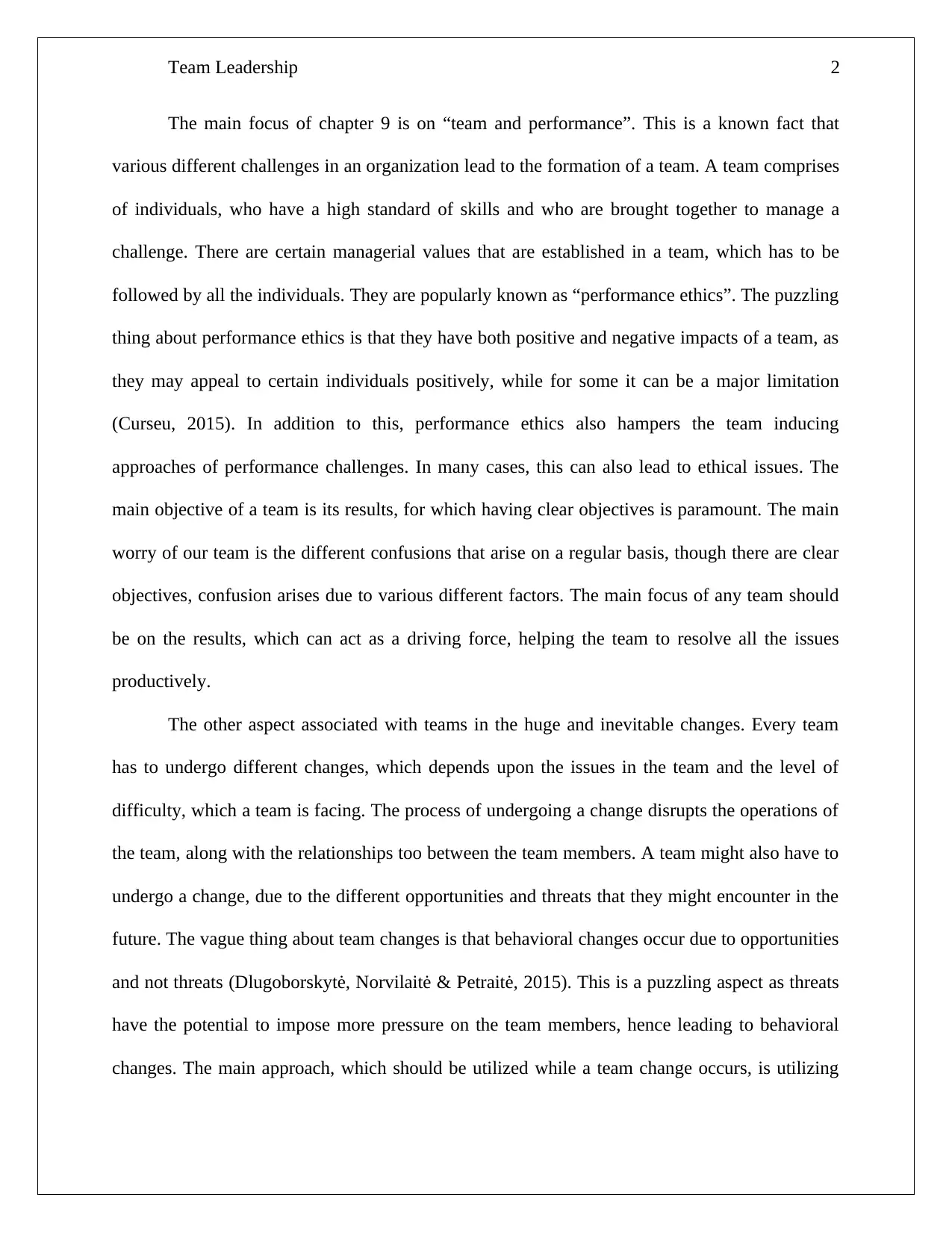
Team Leadership 2
The main focus of chapter 9 is on “team and performance”. This is a known fact that
various different challenges in an organization lead to the formation of a team. A team comprises
of individuals, who have a high standard of skills and who are brought together to manage a
challenge. There are certain managerial values that are established in a team, which has to be
followed by all the individuals. They are popularly known as “performance ethics”. The puzzling
thing about performance ethics is that they have both positive and negative impacts of a team, as
they may appeal to certain individuals positively, while for some it can be a major limitation
(Curseu, 2015). In addition to this, performance ethics also hampers the team inducing
approaches of performance challenges. In many cases, this can also lead to ethical issues. The
main objective of a team is its results, for which having clear objectives is paramount. The main
worry of our team is the different confusions that arise on a regular basis, though there are clear
objectives, confusion arises due to various different factors. The main focus of any team should
be on the results, which can act as a driving force, helping the team to resolve all the issues
productively.
The other aspect associated with teams in the huge and inevitable changes. Every team
has to undergo different changes, which depends upon the issues in the team and the level of
difficulty, which a team is facing. The process of undergoing a change disrupts the operations of
the team, along with the relationships too between the team members. A team might also have to
undergo a change, due to the different opportunities and threats that they might encounter in the
future. The vague thing about team changes is that behavioral changes occur due to opportunities
and not threats (Dlugoborskytė, Norvilaitė & Petraitė, 2015). This is a puzzling aspect as threats
have the potential to impose more pressure on the team members, hence leading to behavioral
changes. The main approach, which should be utilized while a team change occurs, is utilizing
The main focus of chapter 9 is on “team and performance”. This is a known fact that
various different challenges in an organization lead to the formation of a team. A team comprises
of individuals, who have a high standard of skills and who are brought together to manage a
challenge. There are certain managerial values that are established in a team, which has to be
followed by all the individuals. They are popularly known as “performance ethics”. The puzzling
thing about performance ethics is that they have both positive and negative impacts of a team, as
they may appeal to certain individuals positively, while for some it can be a major limitation
(Curseu, 2015). In addition to this, performance ethics also hampers the team inducing
approaches of performance challenges. In many cases, this can also lead to ethical issues. The
main objective of a team is its results, for which having clear objectives is paramount. The main
worry of our team is the different confusions that arise on a regular basis, though there are clear
objectives, confusion arises due to various different factors. The main focus of any team should
be on the results, which can act as a driving force, helping the team to resolve all the issues
productively.
The other aspect associated with teams in the huge and inevitable changes. Every team
has to undergo different changes, which depends upon the issues in the team and the level of
difficulty, which a team is facing. The process of undergoing a change disrupts the operations of
the team, along with the relationships too between the team members. A team might also have to
undergo a change, due to the different opportunities and threats that they might encounter in the
future. The vague thing about team changes is that behavioral changes occur due to opportunities
and not threats (Dlugoborskytė, Norvilaitė & Petraitė, 2015). This is a puzzling aspect as threats
have the potential to impose more pressure on the team members, hence leading to behavioral
changes. The main approach, which should be utilized while a team change occurs, is utilizing
⊘ This is a preview!⊘
Do you want full access?
Subscribe today to unlock all pages.

Trusted by 1+ million students worldwide

Team Leadership 3
problem-solving actions. It is due to this approach that the team will be able to resolve the issues
effectively, along with maintaining a great environment in a team (Leicher & Mulder, 2016).
Another aspect that is associated with teamwork and managing teams is that they form a
team at the top might be an extremely difficult task. There are misconceptions, issues, and many
other problems, which might arise due to it. Furthermore, the discipline that is needed to form a
team at the top, can be difficult to obtain, due to various different issues. It is due to this reason
that many of the prominent professionals have debated between the need of the team and the
effectiveness of the working groups (Furukawa, 2016). The puzzling thing about this aspect is
that working groups have equally high potential in comparison to teams, as the working groups
have focused leaders, whereas in a team leadership is mainly shared, amongst selective
individuals. The main drawback of working groups is that they have individual approaches,
whereas a team works collaboratively. In addition to this, a team focuses on problem-solving
actions, while working groups do not acknowledge this aspect at all (Shetach, 2010).
It is due to these aspects that team problem solving is a major aspect while functioning in
a team. It is a systematic approach, which has to be conducted in a step by step method. For all
the teams, it is important that after identifying the problems, it is crucial to find a solution to it. A
team needs to find multiple solutions, so as to utilize the most appropriate one. The main aspect
that is associated with team problem solving is that it should be conducted in a collaborative
manner. The formation of a team happens to encourage people to work collaboratively. It is due
to this reason that team problem solving can be done, effectively with a collaborative problem-
solving model, which is specially designed for solving team issues (Katzenbach & Smith, 2015).
The collaborative problem-solving model is a six-step model, which helps in understanding the
problem-solving actions. It is due to this approach that the team will be able to resolve the issues
effectively, along with maintaining a great environment in a team (Leicher & Mulder, 2016).
Another aspect that is associated with teamwork and managing teams is that they form a
team at the top might be an extremely difficult task. There are misconceptions, issues, and many
other problems, which might arise due to it. Furthermore, the discipline that is needed to form a
team at the top, can be difficult to obtain, due to various different issues. It is due to this reason
that many of the prominent professionals have debated between the need of the team and the
effectiveness of the working groups (Furukawa, 2016). The puzzling thing about this aspect is
that working groups have equally high potential in comparison to teams, as the working groups
have focused leaders, whereas in a team leadership is mainly shared, amongst selective
individuals. The main drawback of working groups is that they have individual approaches,
whereas a team works collaboratively. In addition to this, a team focuses on problem-solving
actions, while working groups do not acknowledge this aspect at all (Shetach, 2010).
It is due to these aspects that team problem solving is a major aspect while functioning in
a team. It is a systematic approach, which has to be conducted in a step by step method. For all
the teams, it is important that after identifying the problems, it is crucial to find a solution to it. A
team needs to find multiple solutions, so as to utilize the most appropriate one. The main aspect
that is associated with team problem solving is that it should be conducted in a collaborative
manner. The formation of a team happens to encourage people to work collaboratively. It is due
to this reason that team problem solving can be done, effectively with a collaborative problem-
solving model, which is specially designed for solving team issues (Katzenbach & Smith, 2015).
The collaborative problem-solving model is a six-step model, which helps in understanding the
Paraphrase This Document
Need a fresh take? Get an instant paraphrase of this document with our AI Paraphraser
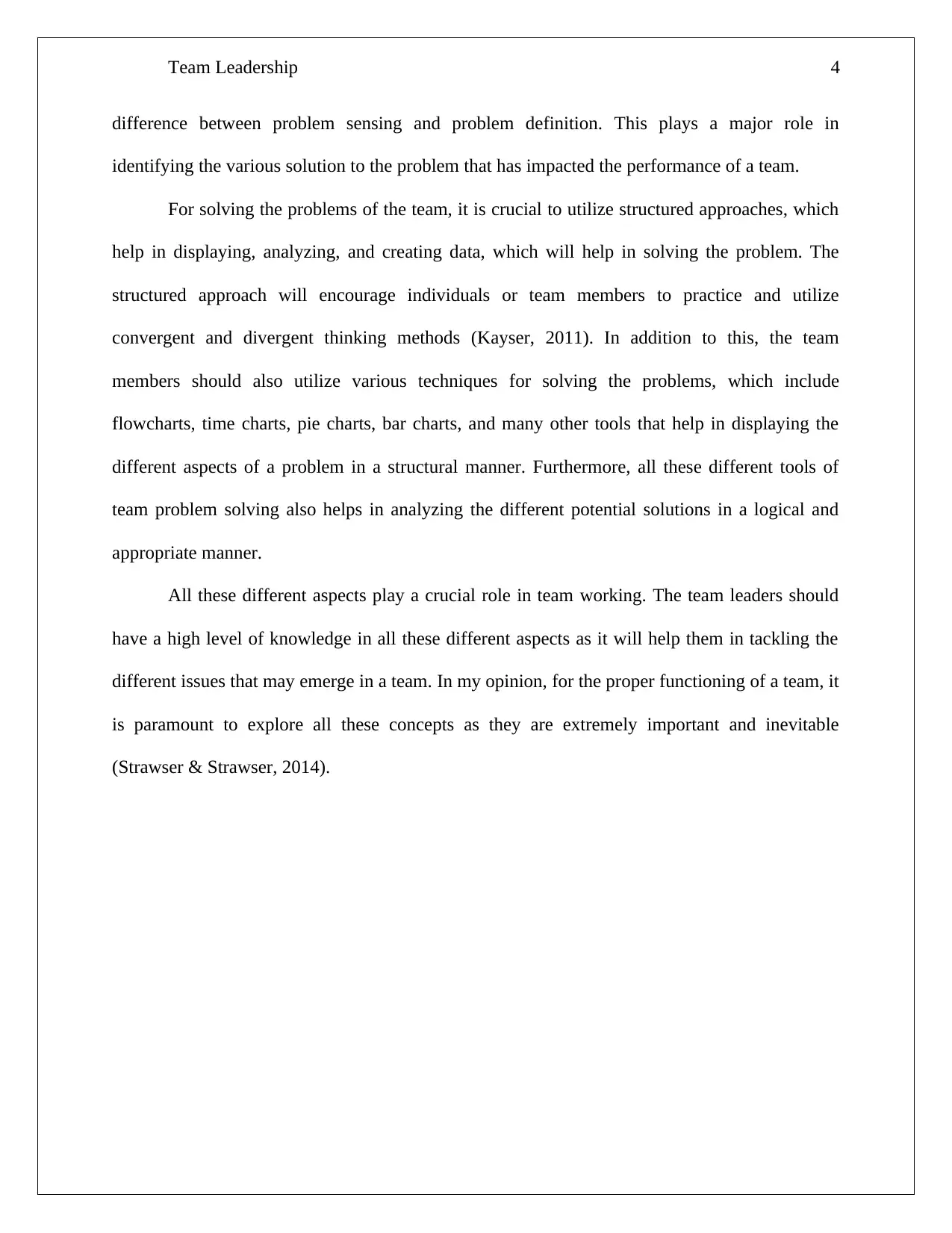
Team Leadership 4
difference between problem sensing and problem definition. This plays a major role in
identifying the various solution to the problem that has impacted the performance of a team.
For solving the problems of the team, it is crucial to utilize structured approaches, which
help in displaying, analyzing, and creating data, which will help in solving the problem. The
structured approach will encourage individuals or team members to practice and utilize
convergent and divergent thinking methods (Kayser, 2011). In addition to this, the team
members should also utilize various techniques for solving the problems, which include
flowcharts, time charts, pie charts, bar charts, and many other tools that help in displaying the
different aspects of a problem in a structural manner. Furthermore, all these different tools of
team problem solving also helps in analyzing the different potential solutions in a logical and
appropriate manner.
All these different aspects play a crucial role in team working. The team leaders should
have a high level of knowledge in all these different aspects as it will help them in tackling the
different issues that may emerge in a team. In my opinion, for the proper functioning of a team, it
is paramount to explore all these concepts as they are extremely important and inevitable
(Strawser & Strawser, 2014).
difference between problem sensing and problem definition. This plays a major role in
identifying the various solution to the problem that has impacted the performance of a team.
For solving the problems of the team, it is crucial to utilize structured approaches, which
help in displaying, analyzing, and creating data, which will help in solving the problem. The
structured approach will encourage individuals or team members to practice and utilize
convergent and divergent thinking methods (Kayser, 2011). In addition to this, the team
members should also utilize various techniques for solving the problems, which include
flowcharts, time charts, pie charts, bar charts, and many other tools that help in displaying the
different aspects of a problem in a structural manner. Furthermore, all these different tools of
team problem solving also helps in analyzing the different potential solutions in a logical and
appropriate manner.
All these different aspects play a crucial role in team working. The team leaders should
have a high level of knowledge in all these different aspects as it will help them in tackling the
different issues that may emerge in a team. In my opinion, for the proper functioning of a team, it
is paramount to explore all these concepts as they are extremely important and inevitable
(Strawser & Strawser, 2014).
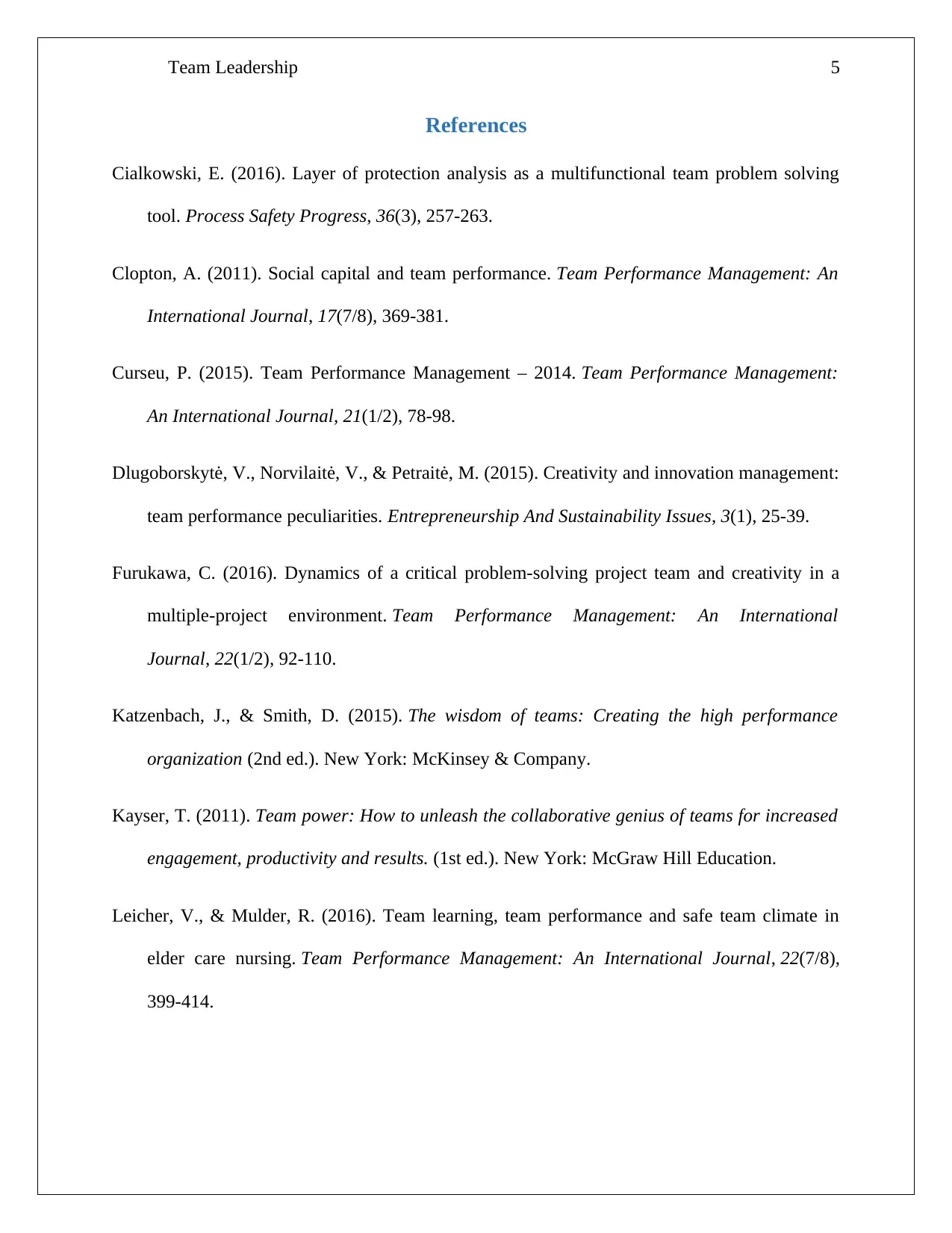
Team Leadership 5
References
Cialkowski, E. (2016). Layer of protection analysis as a multifunctional team problem solving
tool. Process Safety Progress, 36(3), 257-263.
Clopton, A. (2011). Social capital and team performance. Team Performance Management: An
International Journal, 17(7/8), 369-381.
Curseu, P. (2015). Team Performance Management – 2014. Team Performance Management:
An International Journal, 21(1/2), 78-98.
Dlugoborskytė, V., Norvilaitė, V., & Petraitė, M. (2015). Creativity and innovation management:
team performance peculiarities. Entrepreneurship And Sustainability Issues, 3(1), 25-39.
Furukawa, C. (2016). Dynamics of a critical problem-solving project team and creativity in a
multiple-project environment. Team Performance Management: An International
Journal, 22(1/2), 92-110.
Katzenbach, J., & Smith, D. (2015). The wisdom of teams: Creating the high performance
organization (2nd ed.). New York: McKinsey & Company.
Kayser, T. (2011). Team power: How to unleash the collaborative genius of teams for increased
engagement, productivity and results. (1st ed.). New York: McGraw Hill Education.
Leicher, V., & Mulder, R. (2016). Team learning, team performance and safe team climate in
elder care nursing. Team Performance Management: An International Journal, 22(7/8),
399-414.
References
Cialkowski, E. (2016). Layer of protection analysis as a multifunctional team problem solving
tool. Process Safety Progress, 36(3), 257-263.
Clopton, A. (2011). Social capital and team performance. Team Performance Management: An
International Journal, 17(7/8), 369-381.
Curseu, P. (2015). Team Performance Management – 2014. Team Performance Management:
An International Journal, 21(1/2), 78-98.
Dlugoborskytė, V., Norvilaitė, V., & Petraitė, M. (2015). Creativity and innovation management:
team performance peculiarities. Entrepreneurship And Sustainability Issues, 3(1), 25-39.
Furukawa, C. (2016). Dynamics of a critical problem-solving project team and creativity in a
multiple-project environment. Team Performance Management: An International
Journal, 22(1/2), 92-110.
Katzenbach, J., & Smith, D. (2015). The wisdom of teams: Creating the high performance
organization (2nd ed.). New York: McKinsey & Company.
Kayser, T. (2011). Team power: How to unleash the collaborative genius of teams for increased
engagement, productivity and results. (1st ed.). New York: McGraw Hill Education.
Leicher, V., & Mulder, R. (2016). Team learning, team performance and safe team climate in
elder care nursing. Team Performance Management: An International Journal, 22(7/8),
399-414.
⊘ This is a preview!⊘
Do you want full access?
Subscribe today to unlock all pages.

Trusted by 1+ million students worldwide
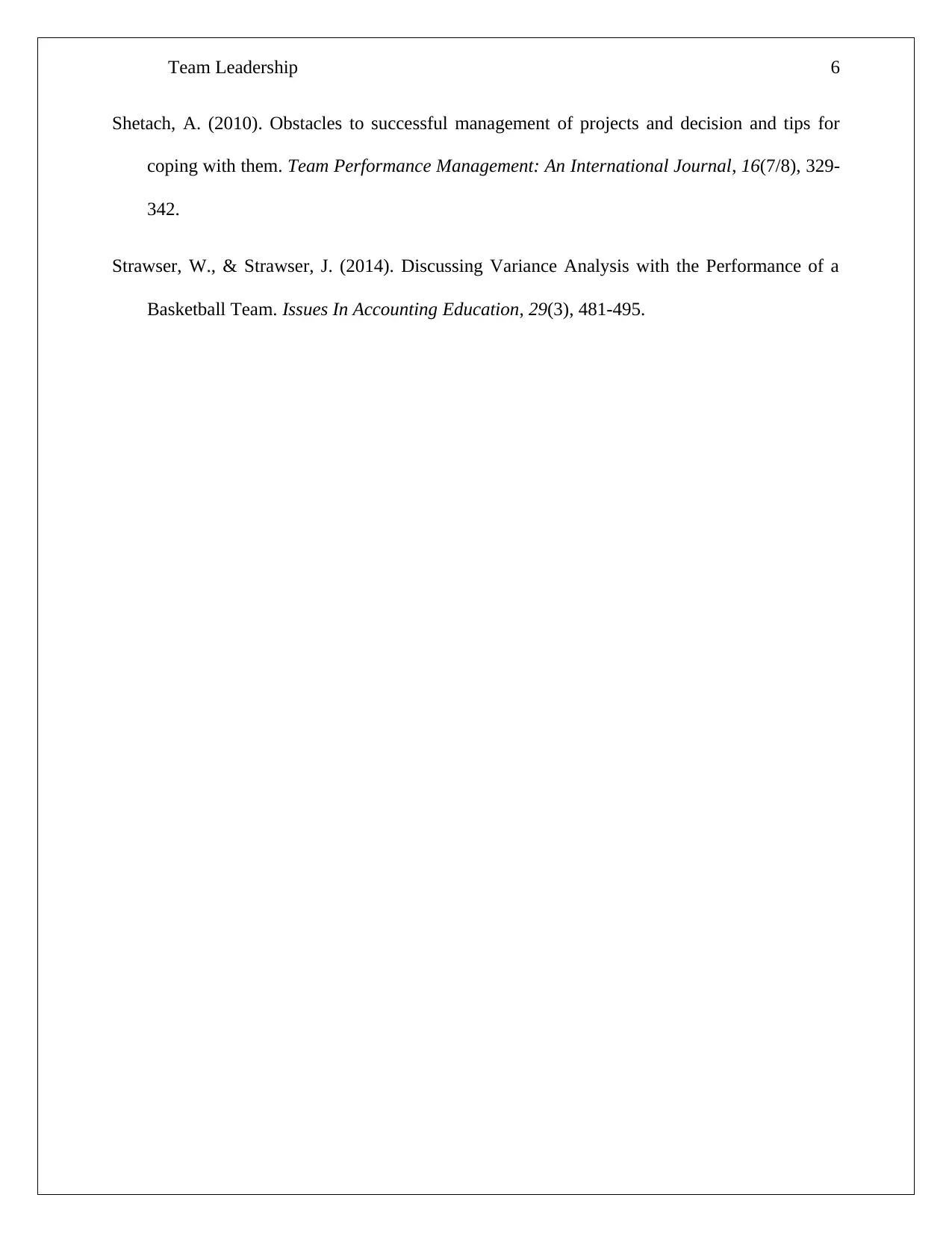
Team Leadership 6
Shetach, A. (2010). Obstacles to successful management of projects and decision and tips for
coping with them. Team Performance Management: An International Journal, 16(7/8), 329-
342.
Strawser, W., & Strawser, J. (2014). Discussing Variance Analysis with the Performance of a
Basketball Team. Issues In Accounting Education, 29(3), 481-495.
Shetach, A. (2010). Obstacles to successful management of projects and decision and tips for
coping with them. Team Performance Management: An International Journal, 16(7/8), 329-
342.
Strawser, W., & Strawser, J. (2014). Discussing Variance Analysis with the Performance of a
Basketball Team. Issues In Accounting Education, 29(3), 481-495.
1 out of 7
Related Documents
Your All-in-One AI-Powered Toolkit for Academic Success.
+13062052269
info@desklib.com
Available 24*7 on WhatsApp / Email
![[object Object]](/_next/static/media/star-bottom.7253800d.svg)
Unlock your academic potential
Copyright © 2020–2025 A2Z Services. All Rights Reserved. Developed and managed by ZUCOL.





